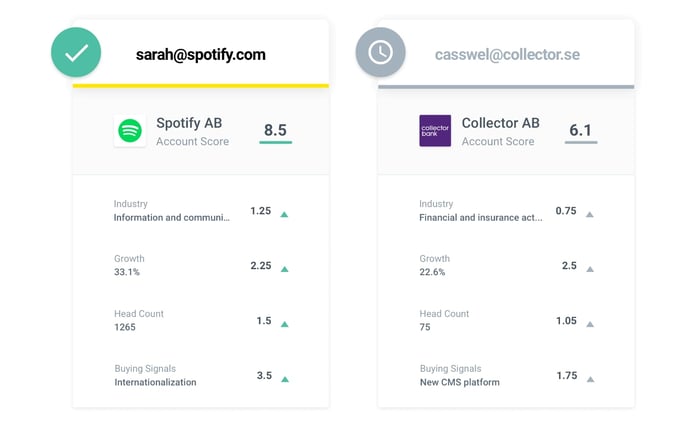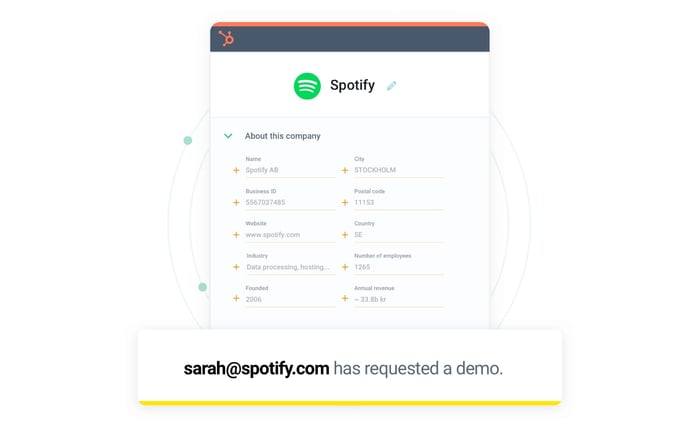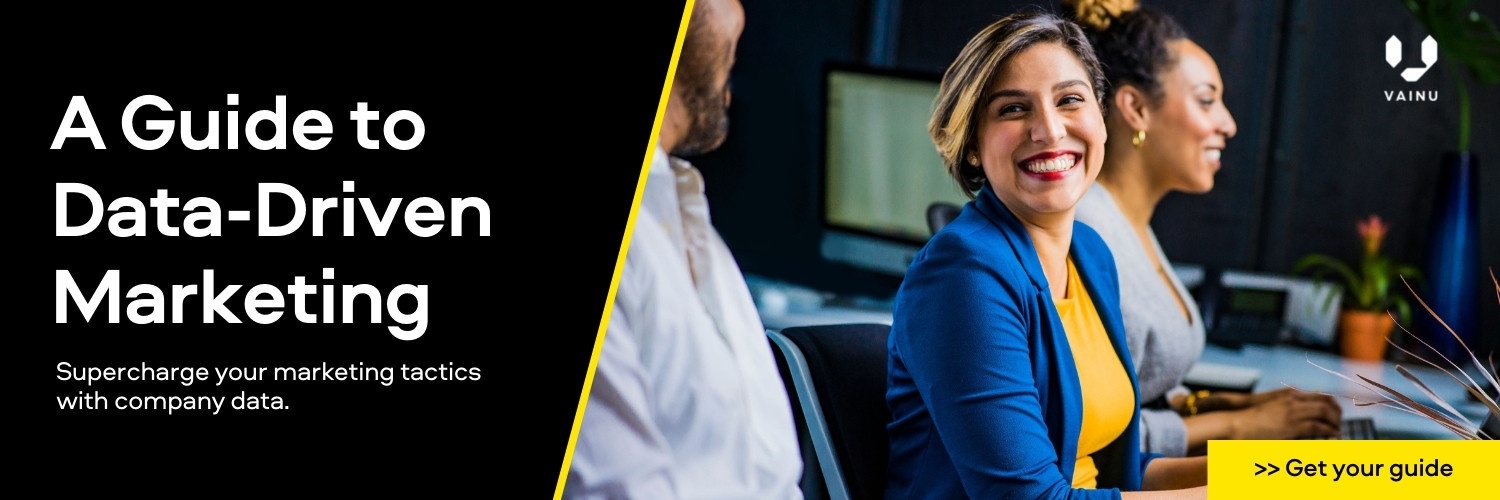Lead Scoring: Setup And Models for B2B Companies
Tick tock, tick tock, tick tock.
There’s little to no rest in sales. Every week, month, or quarter the countdown starts over, and you (or your team) are racing to hit quota against that clock. Time is a commodity in sales. (Like you didn’t know that already.)
There are numerous ways in which you can streamline your sales. One useful way to save time and increase sales is to make sure you’re concentrating on the best available leads, and not wasting time on dead-end ones.
But HOW? How can I improve my b2b lead scoring and make sure I prioritize my valuable time on the leads most likely to close now?
Relax, modern technology can do the groundwork for you. In this blog post, we'll tell you how.
Contents of this blog
- What is lead scoring?
- Is lead scoring for you?
- Why is lead scoring powerful?
- How to set up a lead scoring model
- A step-by-step guide to setting up a lead scoring model
- 3 tips for successful lead scoring
- Lead enrichment
- Lead scoring vs account scoring
- Re-evaluate your lead scoring model with time
What is lead scoring?
Lead scoring is a methodology used to grade prospects against a scale that represents the perceived value each lead represents for your organization. With lead scoring, you can attach values to each of your leads based on their professional information and the behavior they’ve exhibited on your website.
The more likely a lead is to progress further down the sales funnel to end up a paying customer, the better the lead – and the higher the score. Lead qualification is fundamental to prioritizing the leads in your funnel and closing the business you really want.
A good lead scoring model can help you prioritize leads by:
- how likely they are to purchase,
- purchase size, and
- purchasing timeline
Is lead scoring for you?
Lead scoring is, just like basically every other sales and marketing model out there, not for everyone.
There are a few easy questions you should ask yourself before deciding whether lead scoring is beneficial for you or not:
1. Does your marketing team bring in enough leads?
If your sales team doesn’t get fed with more leads than they can handle, you probably don’t need to spend time on setting up a lead scoring framework. Instead, urge the marketing team on focusing on bringing in more leads to the top of the funnel.
2. Does the sales team process the leads they get from marketing?
Is sales complaining about bad leads and marketing complaining about sales not even following up on the leads they provide them? Then you’re probably in greater need of a service level agreement (SLA) than a lead scoring framework. Sit down with both departments and decide on how many leads marketing should deliver to sales each month, and how many sales must follow up with. When your SLA is in place, you can start thinking about lead scoring.
3. Do you have enough data?
You need contextual data, company data and behavioral data on your leads before you can implement a lead scoring framework. (Each type of data is explained more thoroughly here.) If you don’t have the data, you’ll have to do some legwork and look over our data collection methods before you can get started with lead scoring.
If your answer to either of the questions above is “no”, your company probably isn’t ready for lead scoring just yet. If your answer to all of the questions is “yes”, read on.
According to MarketingSherpa’s B2B Benchmarking report, only 21% of sales organizations in the U.S. have established a lead scoring program.
Why is B2B lead scoring powerful?
The work of setting up a b2b lead scoring model should preferably be a collaboration between marketers and salespeople. There is much to gain from both departments agreeing to a common way of discussing and defining a quality lead (Marketing Qualified Lead or MQL) and a sales-ready lead (also called Sales Qualified Lead or SQL).
Here are five common scenarios that b2b lead scoring model is useful for:
1. Prioritize from a long list of leads
If you and/or your team is working with outbound calling, lead scoring helps you prioritize the leads and call the ones with the highest score first. This will increase your hit rate compared to just calling through your list alphabetically.
2. Identify and target leads that need tailored nurturing
Leads come in through marketing efforts every day, and it’s the marketer's job to nurture them until they’re sales-ready leads. If you have an action you want to take only if someone is already at a certain stage, lead scoring will help you drop each lead into the right nurturing campaign. Example: You send out a newsletter that brings people to your campaign landing page, and only when someone has clicked through to your site would you then trigger to send them a webinar invitation.
3. Refine your marketing messages
By segmenting leads and treating leads at each stage of the buying process with different messages, your marketing team can test out different approaches for each stage. This will help the marketing team discover what approach leads with a specific lead score tend to resonate best with.
4. Standardize how leads are evaluated and discussed
As your lead flow increases, make sure sales’ closing rate doesn’t go down by making sure marketing only hand over leads that are ready to have a conversation with a rep to sales. The relationship between sales and marketing is tense in many companies. Marketing teams are often of the opinion that they’re doing something nice for sales when they hand them more leads. Sales doesn’t always appear to appreciate the effort, but instead yawn over the increased number of leads and complain about the poor quality of them. With proper lead scoring, and by giving marketing and sales a common language for discussing the quality and quantity of leads, they’ll naturally align themselves.
5. Don’t stress leads into making a decision
There’s lead nurturing and then there’s pushy, unsolicited sales outreach. The obvious win with lead scoring is that the method helps you understand what leads to focus on now and how to treat these leads. The less obvious benefit is that the model helps sales organizations know what leads NOT to focus on now. This leaves them in an educational sequence that allows them to become warmer leads before they receive a call from a member of your sales team.

How to set up a lead scoring model
The work with setting up a lead scoring model is often made by the marketing team. While the marketing team likely has done some extensive research into your target market, they have a lot to win from inviting sales into the discussion of what makes a good lead. Salespeople are, after all, the ones that are speaking to the market on a daily basis. It’s also the salespeople who will try to close the leads that marketing brings in. Salespeople tend to know what leads they have great success with and which ones they often end up losing.
There are mainly three types of data that you should include in your lead scoring framework:
- Contextual data. What role/job title does the person have? This data you should typically get from your lead gen forms when someone is converting on your website.
- Company data. When it comes to companies, we nowadays talk about account scoring (more on this below) and it can and should be appended into lead scoring. Examples within this framework would be fields such as in what industry is the lead active? What company size, turnover, and a number of employees does the company have? While you can get parts of this data from your lead gen forms, a sales intelligence platform like Vainu that provides you with real-time data on millions of companies can also be of great help.
- Behavioral data. How has the lead been exhibited on your website? Your CMS platform and your marketing automation tool can help you track this automatically.
A step-by-step guide to setting up a b2b lead scoring model
1. List what you require from a lead
Start by establishing the minimum criteria a lead must pass to become a customer.
2. List what characteristics your current customers share
Collect data from both marketing, sales, and customer success. If you already know what qualities your target market or ideal customer profile usually possess, this work is more or less already done. The point is to find prospects similar to your existing customers; they’re very likely good potential customers for you.
3. Visualize your dream lead
What features characterize your dream lead? Are there any specific qualities that indicate that a lead will end up a high-paying customer that provides a great lifetime value for your business?
4. Look at how your current customers behave
And more importantly, how did they behave shortly before they signed a deal with you? What part of your website did they visit? Did they open a number of your marketing emails? Did they click through to your site once they’d opened an email? Did they download a series of white papers or partake in a webinar? Make sure to list as many actions indicating a positive interest in purchasing from you as possible here.
5. Decide on a scoring system
How many points does a lead get for working as a VP for a mid-sized company in industry X? Does the lead lose points if he or she is a student or has visited your career page? In theory, you can set whatever scale you like, but typically, you’ll want to stick to a 0 to 100 scale. Give a block of points for specific “must-have” criteria, so that only leads that match those necessary criteria reach your threshold for qualification.
If you sell multiple products and you decide to set up separate scoring models, you might have to find a more advanced scoring system. Weigh the points in relation to how telling they are about a lead’s readiness to buy.
6. Refine and tweak scores
Changes in your product offering or the market can mean that the image of your “perfect lead” changes. There’s also a risk that no matter how thorough your research, your lead scoring framework has room for improvement. Once you have 30 days or more of data, you can begin to do some analysis:
- Have some of your low-scoring leads converted?
- Did a significant percentage of your highly scored leads not resonate well with your sales efforts?
If you answered yes to either of these questions, you might have to tweak your lead scoring model for it to reach its full potential.
3 tips for successful lead scoring
- Use negative scoring
One of the drawbacks to a model that relies on scoring alone is that scores can become inflated over time. While some characteristics and actions indicate that a lead is solid, others can suggest that it’s quite unlikely to buy from you now. It can, for example, be a good idea to dock points from a lead that hasn’t visited your website the last month, or give minus points to a lead that repeatedly visits your career page, as they may be a job seeker.
- Set up separate scoring models
Are you offering several different products or services? Then it might be worth setting up a separate scoring model for each product/service line. By only using one generic scoring model, the risk is that you’ll miss out on sales. For example, if a prospect is only interested in product A or B, the generic scoring model may not reflect their high-interest level, and the prospect likely doesn’t get the attention from sales that it deserves.
- Set up a lead scoring threshold
Far from all B2B marketing teams have set up a lead scoring threshold that will automatically alert or route leads to sales. Having a threshold in place ensures that leads only be assigned to sales when their lead score indicates that they are sales-ready.
Lead enrichment: get the most out of your leads with company information
Here’s a caveat: the success of your lead scoring model largely depends on your contact data quality. Typically, marketers have improved their database by asking for essential information on their lead capture forms. However, there are only as many questions a form can have before turning prospects away.
In business-to-business, one way to improve the process is by enriching your marketing automation platform with fresh and reliable company data. That’s called lead enrichment. Thanks to this process, you’ll get a better understanding of the companies your leads work for, so you can improve conversion rates while saving hours in the process.
By feeding company information into your tech stack, you can shorten forms to increase conversion. At the same time, you can use company data points as additional criteria in your lead scoring models to do an even better job of prioritizing who to focus on. What should the main theme/topic of our Q4 content be?

Lead scoring vs account scoring
Whereas lead scoring ranks contacts in order based on their likelihood to become a customer, account scoring focuses on the organizations' likelihood of becoming customers.
Especially in B2B, emphasizing account rather than lead score alone is a pretty smart move because an individual person rarely makes the purchase decision individually. You need to take into account the current company situation as well as stakeholder opinion, the technologies already in use, the financial situation, and future events—more on account scoring (and a free template) on this blog post.
Re-evaluate your b2b lead scoring model with time
Because a lead’s activity or business can change from day to day, a lead’s individual score will also change over time. For this reason, lead scoring isn’t something easily done manually. Do some research on what sales tools fit your organization, and let technology make your job easier.
Remember to go through and possibly re-evaluate your lead scoring system every few months. The characteristics and behaviors that distinguish a solid sales-ready lead today might look different in the future.
